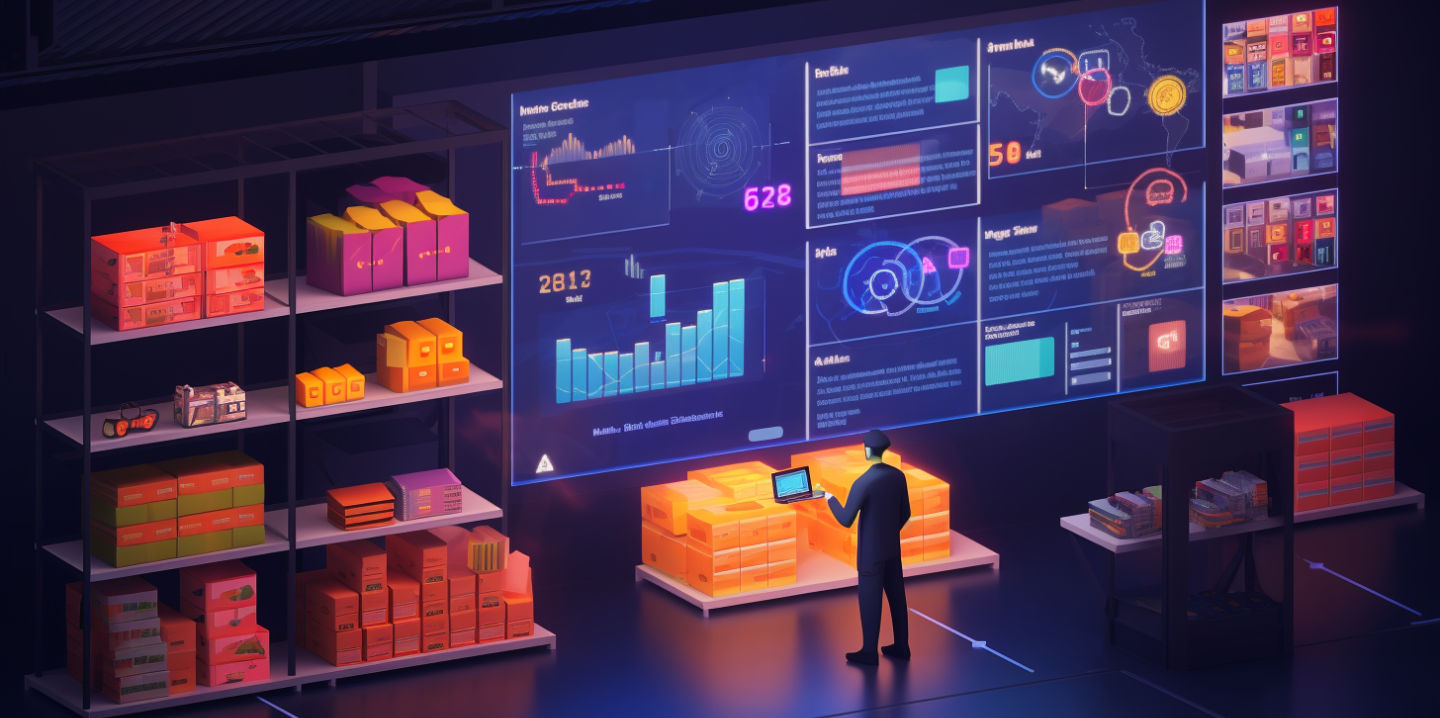

Effective techniques for managing inventory is crucial for businesses in the fast-moving consumer goods (FMCG) industry. For B2B companies, managing inventory efficiently is essential to meeting customer demand, minimizing stockouts, and optimizing cash flow. In this blog post, we will explore proven inventory management techniques tailored specifically for the FMCG sector. By implementing these strategies, B2B organizations can enhance their operational efficiency and ultimately drive greater profitability.
Fast-Moving Consumer Goods (FMCG) play a pivotal role in the B2B landscape, consisting of products with a high turnover rate, low unit value, and widespread distribution. In this context, effective inventory management is essential to sustain a seamless supply chain and meet the dynamic demands of B2B customers.
FMCG in the B2B space encompasses various products such as packaged foods, beverages, personal care items, and household products. Unlike durable goods, FMCG have a short shelf life and are consumed quickly, prompting frequent re-stocking. This characteristic necessitates a different approach to inventory management, focusing on rapid turnover and supply chain agility.
 Photo by Mikhail Nilov
Photo by Mikhail Nilov
Efficient inventory management in the B2B FMCG sector directly impacts customer satisfaction, operational costs, and profitability. Maintaining optimal stock levels reduces the risk of stockouts, enabling timely order fulfillment and fostering strong relationships with B2B clients. Furthermore, streamlined inventory processes contribute to cost savings by minimizing holding costs and reducing the risk of obsolete inventory.
Overall, understanding FMCG and implementing effective inventory management practices within the B2B context is crucial for sustainable growth and competitive advantage in the dynamic market.
Effective inventory management is crucial for B2B companies in the fast-moving consumer goods (FMCG) sector. By utilizing advanced inventory analysis strategies, businesses can optimize their stock levels, reduce carrying costs, and enhance overall operational efficiency.
ABC analysis is a valuable technique for categorizing products based on their significance to the business. This method involves segmenting inventory into three categories:
By implementing ABC analysis, businesses can allocate appropriate resources to manage high-priority products more effectively, while adopting streamlined approaches for lower-priority items.
The Pareto Principle, also known as the 80/20 rule, suggests that roughly 80% of the effects come from 20% of the causes. In the context of inventory management, this principle implies that a significant portion of sales and revenue is derived from a small fraction of the total product range.
Applying the Pareto Principle allows businesses to focus on optimizing the management of their most profitable and high-demand products. By directing attention and resources to the vital 20% of products, companies can achieve substantial improvements in inventory turnover and overall profitability.
Inventory turnover ratios provide valuable insights into the efficiency of stock management. These ratios, such as the inventory turnover ratio and the days sales of inventory (DSI), measure how effectively a company is utilizing its inventory to generate sales.
A high turnover ratio indicates that inventory is selling quickly, reducing the risk of obsolete stock and lowering holding costs. Conversely, a low turnover ratio may signify overstocking or slow-moving products, leading to increased carrying expenses and potential losses.
By closely monitoring turnover ratios and optimizing stock levels based on this analysis, B2B companies can streamline their inventory management processes and achieve greater cost-effectiveness.
 Photo by Mikhail Nilov
Photo by Mikhail Nilov
In the fast-moving consumer goods (FMCG) industry, forecasting demand is crucial for companies to efficiently manage inventory and meet customer needs. Effective demand forecasting involves a combination of strategies to anticipate market trends and consumer behavior.
One of the fundamental approaches to forecasting demand in FMCG is by analyzing historical sales data. By examining past sales patterns, companies can identify seasonal fluctuations, product trends, and market cycles. This data serves as a basis for predicting future consumer demand and making informed inventory decisions.
Trend analysis plays a vital role in forecasting demand for FMCG products. By identifying long-term patterns and shifts in consumer preferences, companies can adjust their inventory levels to align with projected demand. Additionally, seasonal forecasting allows businesses to anticipate peak periods and adjust their stock levels accordingly to prevent stockouts or overstock situations.
Market research is indispensable for understanding consumer behavior, preferences, and purchasing habits. By conducting surveys, collecting feedback, and analyzing market trends, companies can gain valuable insights into evolving consumer needs. Leveraging market research data enables more accurate demand forecasting and helps in adapting inventory strategies to match consumer expectations.
 Photo by fauxels
Photo by fauxels
In managing FMCG inventory, efficient stock replenishment techniques play a crucial role in ensuring smooth operations and customer satisfaction. By optimizing the replenishment process, businesses can minimize carrying costs while meeting demand effectively.
The Economic Order Quantity (EOQ) model aims to determine the ideal order quantity that minimizes total inventory costs. By balancing order and holding costs, businesses can optimize inventory levels to meet customer demand without unnecessary stockpiling. Implementing the EOQ model involves considering factors such as demand variability, ordering costs, and holding costs to arrive at the most cost-effective replenishment quantities.
The Just-in-Time (JIT) inventory system focuses on minimizing inventory holding costs by aligning production with demand. By synchronizing supply chain processes and adopting a pull-based approach, businesses can reduce the risk of overstocking and minimize storage expenses. JIT emphasizes the importance of timely and efficient stock replenishment, promoting agility and cost efficiency in FMCG operations.
 Photo by Mikhail Nilov
Photo by Mikhail Nilov
Vendor-Managed Inventory (VMI) allows suppliers to take responsibility for managing their customers’ inventory levels. This collaborative approach enables businesses to streamline stock replenishment processes, reduce lead times, and enhance supply chain visibility. By leveraging VMI, FMCG companies can benefit from improved accuracy in demand forecasting and reduced stockouts, ultimately driving efficiency and cost savings.
Incorporating these efficient stock replenishment techniques empowers B2B FMCG businesses to optimize inventory management, mitigate carrying costs, and enhance overall operational performance.
In the fast-paced world of B2B FMCG, leveraging cutting-edge technology is pivotal to efficient inventory management. Harnessing the potential of Inventory Management Software Solutions, the Advantages of RFID and Barcoding Systems, and the seamless integration of ERP systems can revolutionize operations and uphold competitive edge.
Utilizing Inventory Management Software Solutions empowers businesses to automate and optimize inventory-related tasks. This software provides real-time visibility into stock levels, facilitates demand forecasting, and enables precise order management. Through intuitive interfaces and robust reporting capabilities, businesses can make well-informed decisions to enhance operational efficiency and adapt promptly to market dynamics.
 Photo by Brett Sayles
Photo by Brett Sayles
The deployment of RFID and Barcode technologies introduces unparalleled accuracy and speed into inventory management processes. RFID technology enables seamless tracking of items, offering real-time insights into stock movement and minimizing human error. Similarly, Barcoding systems provide a cost-effective means to track inventory, streamline check-in and check-out procedures, and enhance overall inventory accuracy, fostering a more efficient supply chain.
 Photo by Kampus Production
Photo by Kampus Production
The integration of Enterprise Resource Planning (ERP) systems with inventory management processes facilitates seamless data flow and synchronization across various departments. By consolidating financials, supply chain, and inventory data into a unified platform, businesses can streamline operations, optimize resource allocation, and gain a holistic view of their inventory management strategies. This amalgamation fosters agility and informed decision-making, propelling organizations towards operational excellence.
 Photo by Kevin Ku
Photo by Kevin Ku
In the fast-moving consumer goods (FMCG) industry, efficient inventory management is crucial for reducing waste and losses. By tackling obsolescence in FMCG products, implementing a robust returns management system, and employing loss prevention strategies and techniques, businesses can optimize their operations and minimize unnecessary expenditures.
Obsolete inventory can tie up valuable warehouse space and drain financial resources. To mitigate obsolescence, FMCG companies should employ data-driven demand forecasting models to anticipate product shelf life and market demand. By utilizing advanced analytics and consumer trend data, businesses can make proactive decisions regarding product lifecycles, thus reducing the risk of holding obsolete stock.
A seamless returns management system is essential for handling product returns efficiently. Streamlining the returns process not only enhances customer satisfaction but also minimizes inventory losses. By implementing an automated returns process and leveraging technology such as barcode scanning and integrated inventory systems, businesses can accurately track returned items, identify salvageable products, and swiftly reintroduce them into the supply chain.
 Photo by Mikhail Nilov
Photo by Mikhail Nilov
Adopting effective loss prevention strategies is pivotal in safeguarding inventory from theft, damage, or spoilage. By utilizing measures such as stringent access controls, surveillance systems, and regular inventory audits, businesses can deter internal and external threats to their inventory. Additionally, implementing secure packaging and storage practices, as well as training staff on proper handling procedures, can help minimize losses due to mishandling or damage.
By addressing obsolescence, optimizing returns management, and implementing comprehensive loss prevention measures, FMCG businesses can significantly reduce waste and losses, thereby bolstering their bottom line and enhancing operational efficiency.
Navigating the fast-moving consumer goods (FMCG) industry involves implementing robust compliance measures and best practices in inventory management. Adhering to industry regulations and standards, implementing sustainable inventory management approaches, and emphasizing continuous improvement and training are essential in optimizing processes and ensuring operational efficiency.
The FMCG sector operates within a framework of stringent regulations and standards aimed at ensuring product quality, safety, and transparency throughout the supply chain. Maintaining compliance with regulatory requirements such as labeling, product traceability, and storage conditions is paramount. By integrating technology-driven solutions and adopting best practices, businesses can streamline compliance processes, mitigate risks, and uphold their commitment to regulatory adherence.
Sustainability is increasingly at the forefront of FMCG operations, prompting companies to adopt environmentally conscious inventory management practices. Leveraging sustainable packaging materials, optimizing transportation routes to reduce carbon footprint, and minimizing excess inventory through demand forecasting contribute to sustainable operations. Embracing eco-friendly initiatives not only aligns with corporate social responsibility but also enhances brand reputation and resilience in a competitive market landscape.
 Photo by Andrea Piacquadio
Photo by Andrea Piacquadio
Embracing a culture of continuous improvement and investing in employee training are pivotal in optimizing inventory management in the FMCG sector. By fostering a learning environment, organizations can empower their workforce to stay abreast of industry advancements, technological innovations, and evolving best practices. Training programs that focus on inventory optimization, waste reduction, and quality management contribute to operational excellence and long-term sustainability.
Incorporating proactive compliance measures, sustainable inventory management approaches, and a steadfast commitment to continuous improvement and training lays a solid foundation for effective FMCG inventory management. These strategic initiatives not only foster operational resilience but also position businesses for sustained growth and success in a dynamic marketplace.
Managing inventory effectively is a crucial aspect of success in the fast-moving consumer goods (FMCG) industry. By examining case studies of major FMCG brands, we can glean valuable insights into successful inventory management strategies, innovations, and outcomes.
FMCG giants deploy sophisticated inventory management systems to ensure optimized stock levels and streamlined supply chains. Companies like Procter & Gamble and Unilever leverage advanced forecasting algorithms and data analytics to anticipate consumer demand and maintain lean inventory levels. These industry leaders prioritize real-time visibility into their supply chain, allowing for proactive decision-making and efficient inventory control.
In the realm of business-to-business (B2B) inventory management, innovative solutions have revolutionized traditional practices. Collaborative forecasting and planning (CPFR) techniques have facilitated enhanced communication and coordination between FMCG suppliers and their B2B partners, leading to reduced stockouts and improved order accuracy. Additionally, the adoption of RFID technology and automated inventory replenishment systems has yielded substantial efficiency gains and cost savings for FMCG businesses.
 Photo by Mikhail Nilov
Photo by Mikhail Nilov
In conclusion, effective inventory management is crucial for B2B FMCG businesses to maintain a competitive edge in the market. By employing techniques such as ABC analysis, safety stock optimization, and demand forecasting, companies can minimize carrying costs and stockouts while maximizing customer satisfaction and profitability. Implementing robust inventory management strategies not only streamlines operations but also paves the way for sustained growth and success in the fast-moving consumer goods industry.